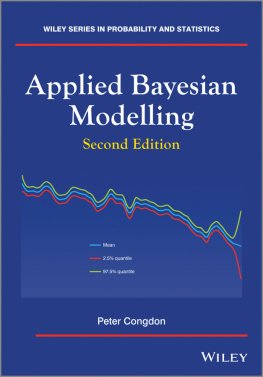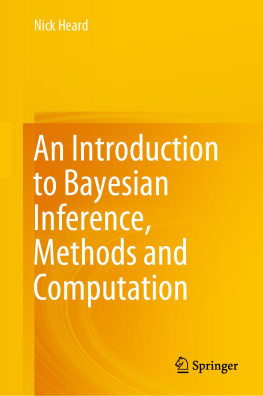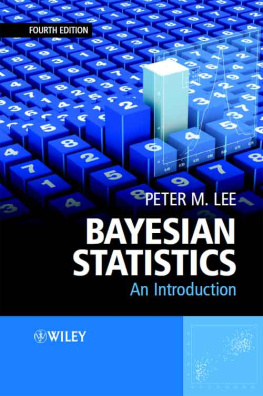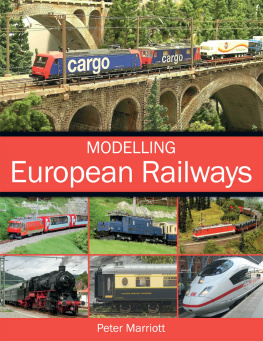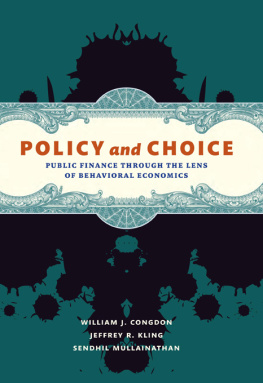Congdon Peter - Applied Bayesian Modelling
Here you can read online Congdon Peter - Applied Bayesian Modelling full text of the book (entire story) in english for free. Download pdf and epub, get meaning, cover and reviews about this ebook. City: West Sussex;U.K, year: 2014, publisher: Wiley, genre: Home and family. Description of the work, (preface) as well as reviews are available. Best literature library LitArk.com created for fans of good reading and offers a wide selection of genres:
Romance novel
Science fiction
Adventure
Detective
Science
History
Home and family
Prose
Art
Politics
Computer
Non-fiction
Religion
Business
Children
Humor
Choose a favorite category and find really read worthwhile books. Enjoy immersion in the world of imagination, feel the emotions of the characters or learn something new for yourself, make an fascinating discovery.
- Book:Applied Bayesian Modelling
- Author:
- Publisher:Wiley
- Genre:
- Year:2014
- City:West Sussex;U.K
- Rating:4 / 5
- Favourites:Add to favourites
- Your mark:
- 80
- 1
- 2
- 3
- 4
- 5
Applied Bayesian Modelling: summary, description and annotation
We offer to read an annotation, description, summary or preface (depends on what the author of the book "Applied Bayesian Modelling" wrote himself). If you haven't found the necessary information about the book — write in the comments, we will try to find it.
Applied Bayesian Modelling — read online for free the complete book (whole text) full work
Below is the text of the book, divided by pages. System saving the place of the last page read, allows you to conveniently read the book "Applied Bayesian Modelling" online for free, without having to search again every time where you left off. Put a bookmark, and you can go to the page where you finished reading at any time.
Font size:
Interval:
Bookmark:

Established by WALTER A. SHEWHART and SAMUEL S. WILKS
Editors: David J. Balding, Noel A. C. Cressie, Garrett M. Fitzmaurice,
Geof H. Givens, Harvey Goldstein, Geert Molenberghs, David W. Scott,Adrian F. M. Smith, Ruey S. Tsay, Sanford Weisberg
Editors Emeriti: J. Stuart Hunter, Iain M. Johnstone, Joseph B. Kadane,Jozef L. Teugels
A complete list of the titles in this series appears at the end of this volume.
This edition first published 2014
2014 John Wiley & Sons, Ltd
Registered office
John Wiley & Sons Ltd, The Atrium, Southern Gate, Chichester, West Sussex, PO19 8SQ, United Kingdom
For details of our global editorial offices, for customer services and for information about how to apply for permission to reuse the copyright material in this book please see our website at www.wiley.com.
The right of the author to be identified as the author of this work has been asserted in accordance with the Copyright, Designs and Patents Act 1988.
All rights reserved. No part of this publication may be reproduced, stored in a retrieval system, or transmitted, in any form or by any means, electronic, mechanical, photocopying, recording or otherwise, except as permitted by the UK Copyright, Designs and Patents Act 1988, without the prior permission of the publisher.
Wiley also publishes its books in a variety of electronic formats. Some content that appears in print may not be available in electronic books.
Designations used by companies to distinguish their products are often claimed as trademarks. All brand names and product names used in this book are trade names, service marks, trademarks or registered trademarks of their respective owners. The publisher is not associated with any product or vendor mentioned in this book.
Limit of Liability/Disclaimer of Warranty: While the publisher and author have used their best efforts in preparing this book, they make no representations or warranties with respect to the accuracy or completeness of the contents of this book and specifically disclaim any implied warranties of merchantability or fitness for a particular purpose. It is sold on the understanding that the publisher is not engaged in rendering professional services and neither the publisher nor the author shall be liable for damages arising herefrom. If professional advice or other expert assistance is required, the services of a competent professional should be sought.
Library of Congress Cataloging-in-Publication Data
Congdon, P.
Applied Bayesian modelling / Peter Congdon. Second edition.
pages cm
Includes bibliographical references and index.
ISBN 978-1-119-95151-3 (cloth)
1. Bayesian statistical decision theory. 2. Mathematical statistics. I. Title.
QA279.5.C649 2014
519.542 dc23
2014004862
A catalogue record for this book is available from the British Library.
ISBN: 978-1-119-95151-3
My gratitude is due to Wiley for proposing a revised edition of Applied Bayesian Modelling, first published in 2003. Much has changed since then for those seeking to apply Bayesian principles or to exploit the growing advantages of Bayesian estimation.
The central program used throughout the text in worked examples is BUGS, though R packages such as R-INLA, R2BayesX and MCMCpack are also demonstrated. Reference throughout the text to BUGS can be taken to refer both to WinBUGS and the ongoing OpenBUGS program, on which future development will concentrate (see http://www.openbugs.info/w/). There is a good deal of continuity between the final WinBUGS14 version and OpenBUGS (for details of differences see http://www.openbugs.info/w.cgi/OpenVsWin), though OpenBUGS has a wider range of sampling choices, distributions and functions. BUGS code can also be simply adapted to JAGS applications and the JAGS interfaces with R such as rjags.
Although R interfaces to BUGS or encapsulating the program are now widely used, the BUGS programming language itself remains a central aspect. Direct experience in WinBUGS or OpenBUGS programming is important as a preliminary to using R Interfaces such as BRUGS and rjags.
For learning Bayesian methods, especially if the main goal is data analysis per se, BUGS has advantages both practical and pedagogical. It can be seen as a half-way house between menu driven Bayesian computing (still not really established in any major computing package, though SAS has growing Bayesian capabilities) on the one hand, and full development of independent code, including sampling algorithms, on the other.
Many thanks are due to the following for comments on chapters or programming advice: Sid Chib, Cathy Chen, Brajendra Sutradhar and Thomas Kneib.
Please send comments or questions to me at .
Peter Congdon, London
Bayesian methods and Bayesian estimation
Bayesian analysis of data in the health, social and physical sciences has been greatly facilitated in the last two decades by improved scope for estimation via iterative sampling methods. Recent overviews are provided by Brooks et al. (2011), Hamelryck et al. (2012), and Damien et al. (2013). Since the first edition of this book in 2003, the major changes in Bayesian technology relevant to practical data analysis have arguably been in distinct new approaches to estimation, such as the INLA method, and in a much extended range of computer packages, especially in R, for applying Bayesian techniques (e.g. Martin and Quinn, 2006; Albert, 2007; Statisticat LLC, 2013).
Among the benefits of the Bayesian approach and of sampling methods of Bayesian estimation (Gelfand and Smith, 1990; Geyer, 2011) are a more natural interpretation of parameter uncertainty (e.g. through credible intervals) (Lu et al., 2012), and the ease with which the full parameter density (possibly skew or multi-modal) may be estimated. By contrast, frequentist estimates may rely on normality approximations based on large sample asymptotics (Bayarri and Berger, 2004). Unlike classical techniques, the Bayesian method allows model comparison across non-nested alternatives, and recent sampling estimation developments have facilitated new methods of model choice (e.g. Barbieri and Berger, 2004; Chib and Jeliazkov, 2005). The flexibility of Bayesian sampling estimation extends to derived structural parameters combining model parameters and possibly data, and with substantive meaning in application areas, which under classical methods might require the delta technique. For example, Parent and Rivot (2012) refer to management parameters derived from hierarchical ecological models.
New estimation methods also assist in the application of hierarchical models to represent latent process variables, which act to borrow strength in estimation across related units and outcomes (Wikle, 2003; Clark and Gelfand, 2006). Letting  and
and  denote joint and conditional densities respectively, the paradigm for a hierarchical model specifies
denote joint and conditional densities respectively, the paradigm for a hierarchical model specifies

based on an assumption that observations are imperfect realisations of an underlying process and that units are exchangeable. Usually the observations are considered conditionally independent given the process and parameters.
Next pageFont size:
Interval:
Bookmark:
Similar books «Applied Bayesian Modelling»
Look at similar books to Applied Bayesian Modelling. We have selected literature similar in name and meaning in the hope of providing readers with more options to find new, interesting, not yet read works.
Discussion, reviews of the book Applied Bayesian Modelling and just readers' own opinions. Leave your comments, write what you think about the work, its meaning or the main characters. Specify what exactly you liked and what you didn't like, and why you think so.

